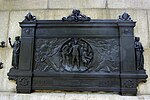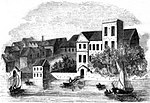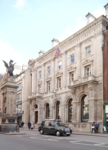Temple, London

The Temple is an area of London surrounding Temple Church. It is one of the main legal districts in London and a notable centre for English law, historically and in the present day. It consists of the Inner Temple and the Middle Temple, which are two of the four Inns of Court and act as local authorities in place of the City of London Corporation as to almost all structures and functions. The Royal Courts of Justice are just to the north and Temple tube station borders to the southwest in the City of Westminster. The associated area is roughly bounded by the River Thames (the Victoria Embankment) to the south, Surrey Street to the west, the Strand and Fleet Street to the north and Carmelite Street and Whitefriars Street to the east. The intervening Essex Street, two streets east of Surrey Street is the traditional western boundary, beyond which are affluent office/hotel and residential blocks, spread over large three street blocks which are closest to the station.
Excerpt from the Wikipedia article Temple, London (License: CC BY-SA 3.0, Authors, Images).Temple, London
Middle Temple Lane, City of London
Geographical coordinates (GPS) Address Nearby Places Show on map
Geographical coordinates (GPS)
| Latitude | Longitude |
|---|---|
| N 51.512 ° | E -0.111 ° |
Address
Plowden Buildings
Middle Temple Lane
EC4Y 9AA City of London
England, United Kingdom
Open on Google Maps










